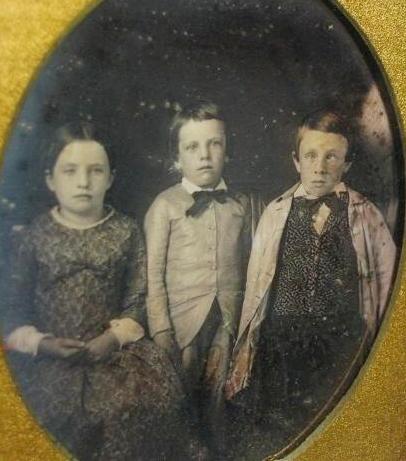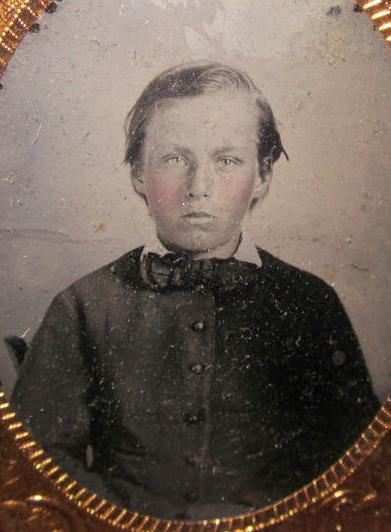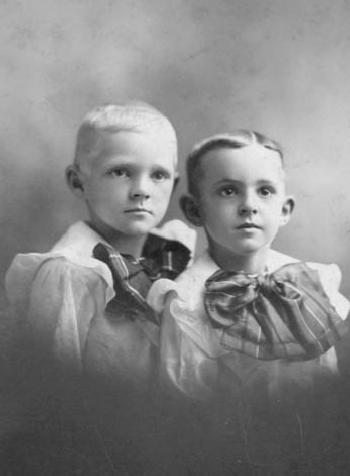
United States Boys' Clothes: Neckwear Chronology--19th Century

Figure 1.--
|
|
We have a great deal of information on 19th century neckwear, especially by mid-century with the development of photography. Boys in the mid 19th century wore black stocks like their fathers. We also see bows. Some of the neckwear seems rather a blend between stocks and small bows. Neckwear seems less common in the 1850s when collars became verysmall. We do not note American boys wearing destinctive neckwear until after the Civil War. We note boys wearing floppy bows in the 1870s, but they were relatively small. We even see small bows in the early 1880s. A good example is Eddie Wilson in 1882. Large bows become standard by the mid-1880s. This changed in the 1880s when we begin to see boys wearing increasingly large bows. Some boys seemed almost enveloped by their bows and large collars. The bows were made in a range of colors and patterns. The large collars of the day were worn both with and without these bows. Boys in the 1890s often wore large ruffled and somewhat older boys Eton collars. Some boys wore floppy bows with these collars, but others wore them without bows. Neckties appeared, but were worn by older boys.
The 1800s
We do not yet have much information on early-19th century neckwear in the United States. We note neckcloths, cravats, stocks, solitaires, jabots, and macaronis. We are not entirely sure of the chronolgy yet. There were no destinctive boy neckwear styles. After nreech, boys wore essentially cut down versions of the outfits their fathers wore. This only began to change in the late-18th century when the skeketon suit appeared. This meant the dramatic appearance of long pants, but the neckwear seems to have been similar to adult styles. We note open collars kin the early-19th century. This mean neckwear was not worn, but some if the collars were noth large and fancy. Of course fabcy neckwear was for the well to do. In the era before the indistrial revolution had begin to change Europe, the affluent class was relatively limited. Fancy neckwear would have been worn by only a small minority.

Figure 5.--This Dag is undated, but we believe was probably taken in the 1840s. Here we welcome reader insights on the dating. The boys wear black stocks that were tied more like bows. We are not yet sure justhow common this was.
|
|
The 1840s
We begin to have much more information on 19th century neckwear in the 1849s with the development of the , especially by mid-century with the development of the Deguerreotype (1839). This the 1840s is the first decade for which we have large mumbers of images. Unfortuntely we can not yet destinguish between Dags taken in the 1840s and 50s. Dags were made in both the 1840s abd 50s, even the 1860s and few were dated. Thus they are difficult to date. Boys in the mid 19th century wore black stocks like their fathers. We also see Dags with boys wearing bows or stocks that were beginning to look like bows. These were even more likelky to be seen in the 1850s, but we see this in the 1840s to some extent. Men wore black stocks were commonly worn in the 1840s, 50s, and early 60s. We suspect that younger boys wearing black stocks were more likrly to date to the 1840s,although men wore stocks jnto the 850s abd even erarly-60s. Wevnote boys wearing blavl stocks with tails. This was less common or adult men. Here dating is a problem and we welcome reader input. Some of the neckwear seems rather a blend between stocks and small bows. A good example is an unidentified young teenager in the 1840s.

Figure 6.--This Ambro is undated, but looks like the 1850s to us. The boy looks to be about 10 years old. He wears a collar-buttoning jacketvand white collar eiyh hat looks like a stock, although a stock tied more loosely than stocks we see most men wearing.
|
|
Neckwear for boys seems less common in the 1850s when collars became very small. The standard neckwear was the stock. Stocks were uually black, but we see some boys wearing brightly colored, patterned stocks. That was sometjhing that was not very common in the 1840s. And when tied that often looked somewhat like bows with tails rather than the partain stocks worn by adult men. These coloful stocks seem to be mostly for boys rather thsn these colorful stocks, but this needs to be pursued in more detail. We do know tht the black stocks were much more common for men and very common. Most men wore them when wearing suits. Very young boys did not wear them, but by about age 10 years or so we see boys wearing them as well at least when dresing up. The photographic record shows, however, that many boys did not have suits. We see, however, a lot more boys wearing suits than in the 40s. We suspect that if they if not wear a suit to the photograpohic studio, that meant they did not have one. Thus most boys did not wear stocks of ogher neckwer in the 50s. The standard stock was tied without tails. which essentially destunguished them from a bow. We note boys with stocks that were done with bows or at least a hint of tails. The Ambtotype appears about 1855. While it is difficult to sparate Dags from the 1840s abd 50s. Here Dags are diffiult to date, but Ambros are easier. Like Dags, few are actually dated. That is tht Ambros arefrom aelatively narro time period, either from the 1850s or very early-60s. Ambros appeared in the mid-50s and thus date from the mid-50s. Even so, there are many of thm because Americans as they began to industrialize were increasingly ffluent. and Amnbros brought down the cost of photography. Some were also done in the early-60s. but the bulk seem to date from the 50s becuse they were very rapidly replaced by the CDV in the early-60s.

Figure 7.--
|
|
The 1860s
The introduction of the CDV means that we suddenly have a huge number of available images to follow fashion trend, including neckwear. CDVs were done in much large numbers than the early formats like Daguerreotype and and Ambrotypes.
We do not note American boys wearing destinctive neckwear until after the Civil War. Stocks were still very common in the early-1860s, at least for men. They seem much less common for boys. Most stocks were stillblack, at least the ones men wore. Many boys did not wear neckwear, but many did. Here we see a lot more boys wearing suits, again a reflection of rising affluence in America's developing industrial economy. Thus we see more boys wearing neckwear. And very few were wearing the stocks that were so common before the War. Neckwear continued to be an optionl item, but we see many boys wearing them. We see several styles of neckwear in the 60s. One was the cross tie which seems to have been particulrly popular, more popular than bows. Cross toes seem less common for adult men, but this we are still looking into.

Figure 8.-- We continue to see boys wearing cross ties in the 1870s. These twins were Jacob and Issac in Reading, Pennsylvania.
|
|
Neckwear was increacingly common and quite varied in the 1870s. Rarely do we see formal portraits with open collars or even buttoned collars without neckwear. This seems part of an increasing formality of dress in America. This was in part associated with both urbanization and the increasing wealth associated with industrialization. We see a major shift from the 1860s when stocks were still worn. The 1870s styles of neckwear were a continuation of the styles which appeared in the 1860s. We no longer see stocks in the 1870s. We see an increasing differential between the neckwear worn by men and boys. We see more boys wearing neckwear and both the neckewear and collars were larger than the 1860s, although still not really very large. We do not see, however, any really large bows and collars. We note boys wearing floppy bows in the 1870s, but they were relatively small. We continue to see boys wearing cross ties done with relstively thin ribbons in the 1870s. Ribbon with bands of varied colors were popular. We see some floppy bows in the 70s, especially the late 70s, but they tended to be very small. We see some bows that look rather like bowties. We do not yet see neckties.

Figure 9.--
|
|
The 1880s
We even see small bows in the early 1880s. A good example is Eddie Wilson in 1882. This changed in the 1880s when we begin to see boys wearing increasingly large bows. Both bows and collsars grew in size. It is unclesar if one led the other. The bows were worn on top of the collsars and in some cases you can't see the bollars very well. Large bows become standard by the mid-1880s. Some boys seemed almost enveloped by their bows and large collars. The bows were made in a range of colors, ibcluding black and white. Unfortuntely the black an white photography maakes it impossible to tell what the colors were, but we know hst bright colors were often worn. There were also many different patterns, including polka dots, stripes, and plaids. The large collars of the day were worn both with and without these bows. They were tied in different styles of knots. The bows were mostly worn by preteens. As a rule it seemed the younger the boy, the lsrger the bow. Girls also wore bows, but not as commonly asnd not in such big sizes.

Figure 10.--Boys in the 1890s commonly wore big fancy ruffled collars with large floppy bows. These brothers wear similar blouses, but different floppy bows. The studio was Collyer in Waterbury, Connecticut.
|
|
The 1890s
Boys in the 1890s often wore large ruffled and somewhat older boys Eton collars. Some boys wore floppy bows with these collars, but others wore them without bows. Thuis varied from family to family. While certainly not universal, large floppy bows were very common for boys and even somne younger teenagers. Blouses with fancy collars were mafe for boys up to 12-13 years of age. Not all boys wore them with floppy bows, but many pre-teens did. Neckties were also worn, but were worn by older boys.
HBC

Navigate the Boys' Historical Clothing Web Site:
[Return to the Main U.S. neckwear chronology page]
[Return to the Main U.S. neckwear page]
[Return to the Main U.S. country garment page]
[Introduction]
[Activities]
[Biographies]
[Chronology]
[Clothing styles]
[Countries]
[Bibliographies]
[Contributions]
[FAQs]
[Glossaries]
[Images]
[Registration]
[Tools]
[Boys' Clothing Home]
Created: 1:28 AM 2/21/2010
Last updated: 4:23 AM 5/9/2012



